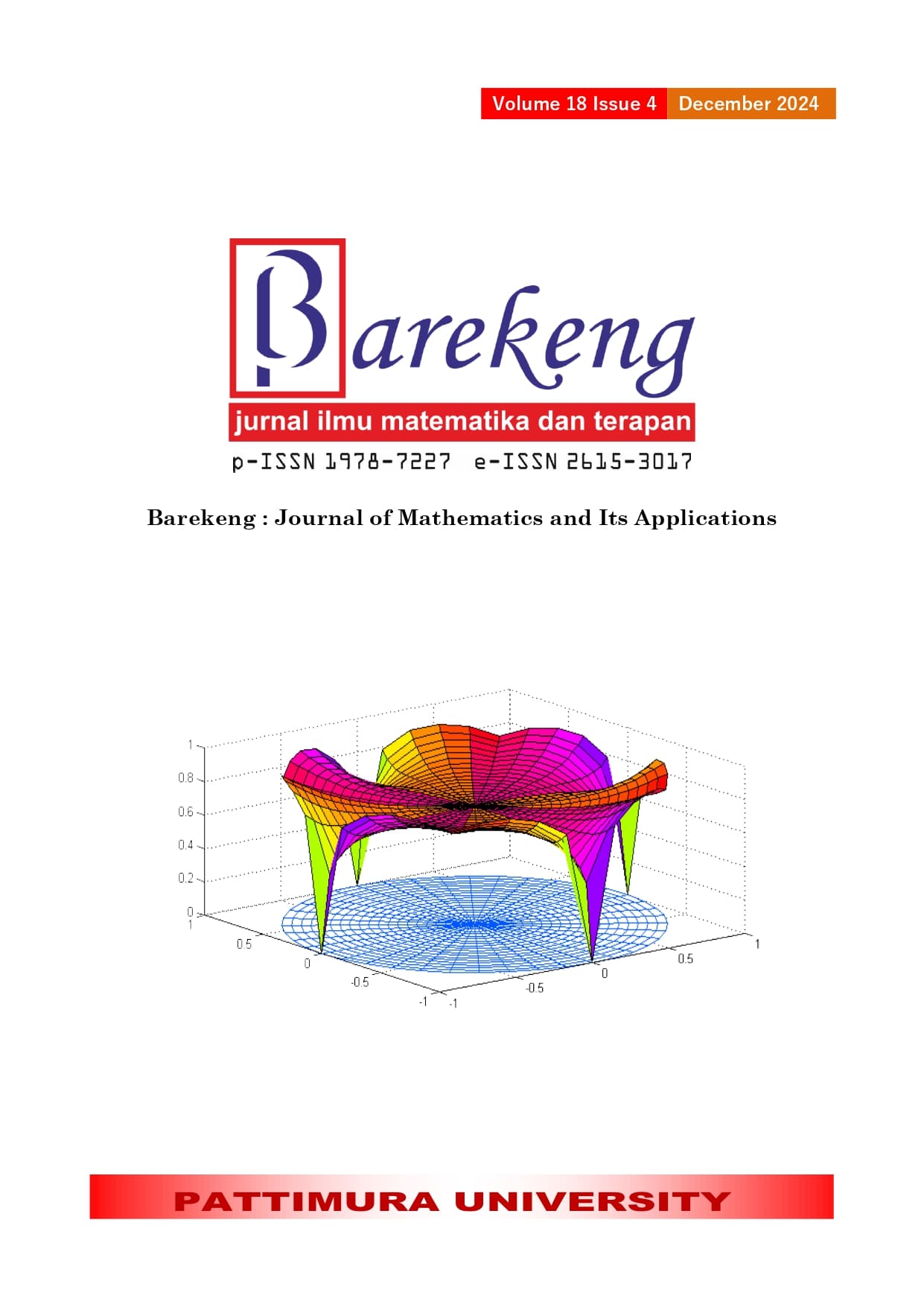FACTORS AFFECTING INDONESIAN PADDY HARVEST FAILURE: A COMPARISON OF BETA REGRESSION, QUASI-BINOMIAL REGRESSION, AND BETA MIXED MODELS
Abstract
The Paddy harvest failure rate is one of the key aspects in determining the total number of claims in a crop insurance policy. It is also an important factor indicating the fulfillment of targeted total production. Therefore, we proposed Beta Regression, Quasi Binomial Regression, and Beta Mixed Models which can be used to analyze significant variables affecting paddy harvest failure rates. Model selection and evaluations indicated that the Nested Beta Mixed Model is the best. Previous research has shown four significant fixed effect variables: drought, flood, pests, and disease risks. Pests and other types of risks also affect the variability of loss rate. All variables have positive effects, indicating higher values cause a higher possibility of a higher average harvest failure rate. High variability was shown for province, municipality, and farmers' random effects. Hence, to prevent a more significant loss rate, MoA should consider more intensive and innovative participatory activities in farmer groups to enhance good farming practices, especially for farmers who suffer from certain risks. These activities should also consider the local characteristics of each province or municipality. As for AUTP development and improvement, farmers with lower failure risks could be given a discounted premium to make it more appealing.
Downloads
References
S. M. Pasaribu and A. Sudiyanto, “Agricultural risk management: Lesson learned from the application of rice crop insurance in Indonesia,” Climate change policies and challenges in Indonesia, pp. 305–322, 2016.
R. and S. V. A. and T. K. S. Kusumaningrum Dian and Anisa, “Alternative Area Yield Index Based Crop Insurance Policies in Indonesia,” in Mathematical and Statistical Methods for Actuarial Sciences and Finance, M. and P. C. and P. C. and S. M. Corazza Marco and Gilli, Ed., Cham: Springer International Publishing, 2021, pp. 285–290.
A. S. E. Hidayat and A. C. Sembiring, “Application of the Historical Burn Analysis Method in Determining Rainfall Index for Crop Insurance Premium Using Black-Scholes,” Journal of Actuarial, Finance, and Risk Management, vol. 2, no. 2, pp. 1–9, 2023.
A. S. E. Hidayat and G. Gunardi, “Calculation of crop insurance premium based on dependence among yield price, crop yield, and standard rainfall index using vine copula,” in AIP Conference Proceedings, 2019.
W. Estiningtyas, “Asuransi pertanian berbasis indeks iklim: opsi pemberdayaan dan perlindungan petani terhadap risiko iklim,” Jurnal Sumberdaya Lahan, vol. 9, no. 1, 2015.
F. Cribari-Neto and A. Zeileis, “Beta Regression in R,” J Stat Softw, vol. 34, no. 2, 2010, doi: 10.18637/jss.v034.i02.
A. Mishra, D. Tiwary, and S. K. Singh, “A class of quasi-binomial distributions,” Sankhyā: The Indian Journal of Statistics, Series B, pp. 67–76, 1992.
P. C. Consul, “A simple urn model dependent on predetermined strategy, Sankhya, B, 36,” 1974.
P. C. Consul and S. P. Mittal, “A new urn model with predetermined strategy,” Biom Z, vol. 17, no. 2, pp. 67–75, Jan. 1975, doi: 10.1002/bimj.19750170202.
S. Ferrari and F. Cribari-Neto, “Beta regression for modelling rates and proportions,” J Appl Stat, vol. 31, no. 7, pp. 799–815, 2004.
S. L. P. Ferrari, P. L. Espinheira, and F. Cribari-Neto, “Diagnostic tools in beta regression with varying dispersion,” Stat Neerl, vol. 65, no. 3, pp. 337–351, 2011, doi: https://doi.org/10.1111/j.1467-9574.2011.00488.x.
F. M. Bayer and F. Cribari-Neto, “Model selection criteria in beta regression with varying dispersion,” Commun Stat Simul Comput, vol. 46, no. 1, pp. 729–746, Jan. 2017, doi: 10.1080/03610918.2014.977918.
M. Smithson and J. Verkuilen, “A better lemon squeezer? Maximum-likelihood regression with beta-distributed dependent variables.,” Psychol Methods, vol. 11, no. 1, pp. 54–71, Mar. 2006, doi: 10.1037/1082-989X.11.1.54.
A. B. Simas, W. Barreto-Souza, and A. V. Rocha, “Improved estimators for a general class of beta regression models,” Comput Stat Data Anal, vol. 54, no. 2, pp. 348–366, Feb. 2010, doi: 10.1016/j.csda.2009.08.017.
R. W. M. WEDDERBURN, “Quasi-likelihood functions, generalized linear models, and the Gauss—Newton method,” Biometrika, vol. 61, no. 3, pp. 439–447, 1974, doi: 10.1093/biomet/61.3.439.
P. McCullagh, Generalized linear models. Routledge, 2019.
D. A. Williams, “Extra-Binomial Variation in Logistic Linear Models,” Appl Stat, vol. 31, no. 2, p. 144, 1982, doi: 10.2307/2347977.
C. E. McCulloch, “AN INTRODUCTION TO GENERALIZED LINEAR MIXED MODELS,” Conference on Applied Statistics in Agriculture, Apr. 1996, doi: 10.4148/2475-7772.1314.
B. Bolker, “Getting started with the glmmTMB package,” Cran. R-project vignette, vol. 9, 2019.
Copyright (c) 2024 Dian Kusumaningrum, Agus Sofian Eka Hidayat, Khairil Anwar Notodiputro, Anang Kurnia, Bagus Sartono, I Made Sumertajaya

This work is licensed under a Creative Commons Attribution-ShareAlike 4.0 International License.
Authors who publish with this Journal agree to the following terms:
- Author retain copyright and grant the journal right of first publication with the work simultaneously licensed under a creative commons attribution license that allow others to share the work within an acknowledgement of the work’s authorship and initial publication of this journal.
- Authors are able to enter into separate, additional contractual arrangement for the non-exclusive distribution of the journal’s published version of the work (e.g. acknowledgement of its initial publication in this journal).
- Authors are permitted and encouraged to post their work online (e.g. in institutional repositories or on their websites) prior to and during the submission process, as it can lead to productive exchanges, as well as earlier and greater citation of published works.






1.gif)



